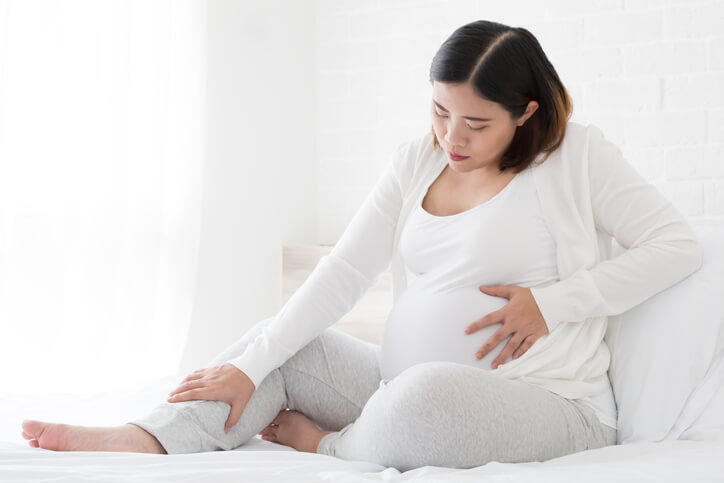After a long day, you need a good night of rest, especially if you are pregnant. However, pregnancy leg cramps and leg pain can be especially bothersome at night and make it virtually impossible to get any rest.
We’ll cover the causes of leg cramps, when you can expect to have pregnancy leg cramps, and what you can do to avoid them.
What Causes Pregnancy Leg Cramps?
Experts aren’t sure. Usually, people experience cramps in their leg muscles in the second or third trimester of pregnancy.
Although they can happen at any time, they are most famous for happening at night.
Although there’s no sure cause, leg cramps could happen because of increased blood flow all over your body that pools and collects in your lower extremities, causing swelling, pain, and cramping.
They could also occur because of the extra weight gain carried during pregnancy or because an expanding tummy can cause organs and tissues to shift around and press on certain nerves resulting in cramps.
Another theory says cramps may happen due to a lack of calcium during pregnancy. Pregnant people need at least 1,000 mg of calcium per day during their pregnancies.
What Do Pregnancy Leg Cramps Feel Like?
Pregnancy leg cramps feel like a muscle contraction or a Charlie horse. Muscles in the calves and feet are often the most affected.
These cramps can also feel like a strained muscle or muscle spasm.
Usually, cramps last only a few minutes and then quickly go away. Sometimes they last less than a minute but can be very intense.
Who Gets Pregnancy Leg Cramps?
Leg cramps during pregnancy are common, with 30-50 percent of pregnant people experiencing them at least once during their pregnancies.
Nine Tips To Deal With Pregnancy Leg Cramps
If you’re tired of the cramps, you can take these steps to reduce them.
1. Stretch Your Calves
Keeping your calf muscles warm and limber will help you avoid many cramps. If you normally get cramps at night, stretch your calves before bed. You can do calf stretches two ways:
- Calf raises. Standing with your feet slightly apart and your hands resting on a table, slowly raise your heels off the floor and hold for several seconds before lowering down.
- Calf stretches on a stair. Stand with the balls of your feet on a stair and your heels hanging off the stair. While holding on to a handrail, slowly lower your heels to tolerance and bring them back to starting position.
2. Magnesium
Although your prenatal vitamin probably contains all the magnesium you need, taking more may help you avoid leg cramps.
Magnesium plays a role in muscle contraction, and deficiency could cause your muscles to spasm or cramp involuntarily.
Talk to your doctor before taking a magnesium supplement, as they can have a laxative effect that could cause dehydration.
Additionally, you can try to get additional magnesium from your diet, like beans, whole grains, some dried fruits, and seeds.
Ask your OB/GYN for information on additional aids that may help, like vitamin B or calcium supplements.
3. Get a Massage
Prenatal massage is a form of massage therapy that focuses on the specific needs of pregnant people.
From helping relax strained back muscles to caring for tired, swollen feet, prenatal massage can be an incredibly valuable part of your prenatal care.
Look for a massage therapist specializing in prenatal massage to ensure your massage is safe. Certain positions (like lying on your stomach) aren’t safe during pregnancy.
4. Ditch the Heels
Pregnancy is no time to mistreat your feet. If you live for a great stiletto, you could be setting yourself up for nighttime foot pain.
Wearing heels with swollen feet and ankles can cause additional stress on the bones of your feet and place extra strain on your calves.
Instead, opt for comfortable, supportive footwear that cushions your feet and supports your lower legs while you walk.
5. Get Enough H20
You already know you need plenty of water during pregnancy.
Even though it probably seems like you’re already in the bathroom a lot, leg cramps could indicate dehydration. If your urine is dark yellow, you’re not getting enough water.
Aim for at least 8-10 glasses of water per day. Keep in mind that other fluids count toward that goal, but anything that contains caffeine is a diuretic and can cause you to lose water.
6. Increase Your Calcium Intake
If you aren’t getting enough calcium, you could be getting crampy legs.
Your prenatal vitamin should have you covered but check with your doctor to ensure you’re getting 1,000 mg daily.
If you still have muscle cramps, try drinking a glass of milk before bed.
7. Elevate
Swollen feet, calves, and ankles are a well-documented pregnancy side effect, especially as your pregnancy reaches the second and third trimesters.
Elevating your legs for even fifteen minutes, several times daily, can alleviate swelling and help decrease the pressure on your lower extremities.
When elevating your legs, keep your feet above your heart, as this will help you get the maximum benefit from elevation and give you the most relief possible.
Searching pregnancy products? We have some recommendations! 🤰🤰
👶👶 TOP RECOMMENDATION: The Genate Prenatal Nutritional Test: Optimize the prenatal nutrition you share with your developing baby or newborn: LEARN MORE.
——- Additional Recommendations ——
📚 Mayo Clinic Guide to a Healthy Pregnancy, 2nd Edition: LEARN MORE.
📚 The Pregnancy Encyclopedia: All Your Questions Answered: LEARN MORE.
🧘 WorkoutLabs Prenatal Yoga & Ayurveda Cards: LEARN MORE.
*If you buy something from a link on our site, we may earn a commission. See our advertising disclosure.
8. Sleep With a Pillow Between Your Knees
Chances are, you are sleeping on your side by the time you begin having leg cramps.
Because it can be virtually impossible to elevate your legs in this position, you can try sleeping with a pillow between your knees.
This position will take pressure off your spine, which may help alleviate nerve pain that could be causing your legs to cramp during the night.
9. Get Moving
As long as your doctor approves, regular exercise is integral to a healthy pregnancy.
Walking daily for ten minutes can help keep your muscles toned and prevent cramps and spasms.
Prenatal yoga is another option to help keep your body strong, your tendons and ligaments limber, and help you avoid cramps.
What To Do If You Get a Leg Cramp
Doing all the right things and still getting leg cramps can happen. When one strikes, here’s how to get it to release as quickly as possible.
- Extend your leg with your heel first, and your toes pointed upward. Gently massage the affected area while wiggling your toes or making small circles with your ankle until the cramp releases.
- Try to walk. If you can move around, walking may help release the cramp and give you relief.
- Heat or Ice. Applying heat or ice can help relax the muscle and release the cramp.
- Soak. If you still can’t get relief, try a warm bath. Ensure the temperature is not warmer than 100 degrees Fahrenheit, so it doesn’t raise your core body temperature.
- Grab a banana. Bananas contain magnesium and potassium, which can help relax cramping muscles and help you find relief.
When To Call a Doctor
If you experience leg cramps along with any of the following symptoms, call your health care provider or obstetrics and gynecology physician immediately to find out if you need medical intervention.
- The site of the cramp is warm to the touch, swollen, or red
- You have a fever
- The pain does not go away after half an hour
- You can’t walk or experience intense pain when trying to walk
These symptoms could indicate a more serious condition that needs an evaluation from your provider.
Don’t Let Leg Cramps Cramp Your Style
Pregnancy leg cramps can feel intense, but they usually don’t last very long.
Certain lifestyle changes and adjustments can help you experience fewer leg cramps, but if you still get them, remember that they don’t last forever.
Staying active, hydrating, and stretching can help you overcome leg cramps and rest better at night.
Talk to your doctor if you still experience leg cramps that keep you awake at night or include other symptoms.
References, Studies and Sources:
Nutrition During Pregnancy | ACOG
Leg cramps during pregnancy: how to avoid them | NCT
Leg Cramps During Pregnancy | American Pregnancy

Bridget Reed is a Tampa-based content development manager, writer, and editor at GR0; specializing in content related to varying fields including medicine, health, and small businesses. Bridget went to St. Petersburg College and majored in Management and Organizational Leadership.
Recent Publications: Body Acne 101: Prevention and Treatment, Stress Acne: Causes, Prevention, and Treatment, What are the Side Effects of Midol?

